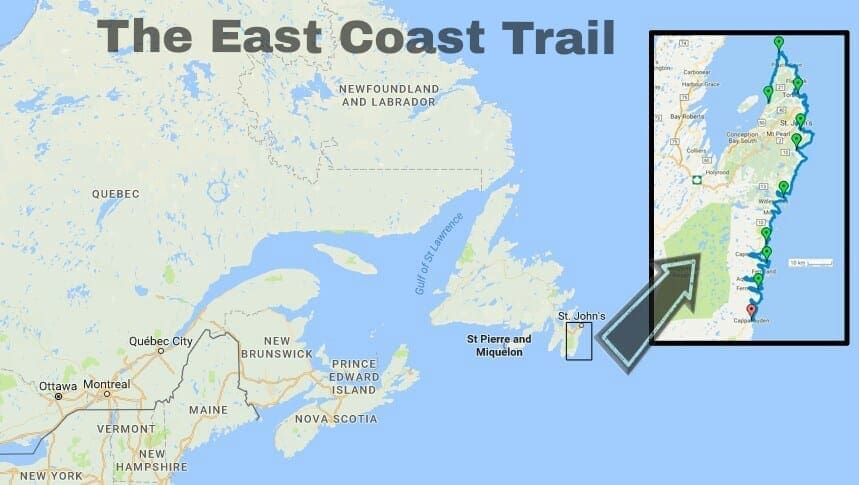What is the East Coast Trail?
The East Coast Trail is found on the north, northeast, and eastern aspects of the Avalon Peninsula. It’s a coastal trail that showcases some of Atlantic Canada’s best coastal scenery and hiking paths.
How long is the East Coast Trail?
The official length of the East Coast Trail is 306 kilometers, but that’s not including the multitude of other East Coast Trail hikes and pathways like the winter snowshoe to the spout unofficial winter shortcut or the old miner’s path that’s not listed at all on the official East Coast Trail map.

How much time should I spend hiking the East Coast Trail during my visit to Newfoundland?
Most East Coast Trail hikers will choose to hike sections of the trail during their time in Newfoundland, but the coastal hiking is so great, many hikers choose to go further and explore more, some hiking the entire length of the East Coast Trail during their Newfoundland Staycation or Vacation. The East Coast Trail is loved by locals and visitors alike, with many sections passing through some of the most interesting communities in Eastern Newfoundland like the towns of Mobile and Tors Cove that offer some of the best whale watching and seabird viewing opportunities in Canada. If hiking the Tinkers Point to Tors Cove East Coast Trail Hike, be sure to plan on enjoying part of your day in Cribbies Meadows in the town of Tors Cove, one of our favorite spots to spend a lazy afternoon. Most hikers spend an average of three days exploring various sections of the East Coast Trail, which is just long enough to get a little taste of what the East Coast Trail has to offer.
Are there moose on the East Coast Trail?
Yes, there are lots of moose on the East Coast Trail, and your chances of seeing one are better in Newfoundland than anywhere else on Earth. Newfoundland has the largest moose population in the world, and the East Coast Trail takes you through prime moose habitat. Did you know, however, that moose are not native to Newfoundland?
Are moose dangerous?
While most Newfoundland moose encounters are peaceful, it’s important to remember that they are a large wild animal and should be given the distance and respect they deserve. Moose, if threatened or protecting their young, can be aggressive and dangerous. Enjoy seeing a Newfoundland moose in the wild, it’s a special experience, but keep your distance to ensure all wildlife encounters are positive.
Are there polar bears in Newfoundland?
Yes, sometimes. Polar bears are marine mammals that primarily live on the ocean, but occasionally polar bears land on the island of Newfoundland temporarily when sea ice conditions are less than ideal or when hunting is challenging. Your chances of a Polar Bear encounter on the East Coast Trail is almost zero, but polar bears do float down to Newfoundland on sea ice from time to time. With climate change impacting sea ice patterns and marine mammal migrations, there have been increased sightings of polar bears in Newfoundland over recent years. Although polar bear sightings in Newfoundland are primarily concentrated along Newfoundland’s Great Northern Peninsula, polar bears have been found in all parts of coastal Newfoundland, including places like the Witless Bay Marine Ecological Reserve
Are there black bears on the East Coast Trail?
Yes, there are black bears on the East Coat Trail and on the Avalon Peninsula. Newfoundland has a healthy population of black bears. When reading about Newfoundland black bears, you may find articles claiming black bears do not exist on Newfoundland’s Avalon Peninsula. Although this has been the generally accepted theory for years, it’s been disproven. It was thought black bears did not live on the Avalon Peninsula, but repeated sightings over the last few years have proven this to be false. Your chances of seeing a black bear on the East Coast Trail is low, but that doesn’t mean you shouldn’t practice proper bear awareness techniques by storing your food properly and keeping a distance from any black bear. Normally, black bears will do their own thing, often preoccupied with whatever berries they’re eating at the time, but if they feel threatened, and especially when they have cubs with them, bears can become aggressive.
Will my mobile phone work on the East Coast Trail?
Reception along the East Coast Trail is really good but there are sections where the signal drops. Don’t expect to be connected all the time, but you will usually be able to pick up a signal at the top of most hills even when you’re in a poor coverage area. Both Bell Canada and Telus Mobility, the two main Canadian mobile phone carriers, have excellent connectivity throughout eastern Newfoundland, so staying connected in this part of the world is easy.

How do I choose the best campsite on the East Coast Trail?
This is a loaded question and depends on many factors. If you’re new to camping or have never camped in a northern climate, be sure to do some research on camping basics before you go, like the importance of a sleeping pad, how to choose the right sleeping bag, and how to properly store your food when camping. There is a lot of information online when it comes to camping basics, and a visit to your local outdoor store can help you get started.
When it comes to camping specifics in Newfoundland, keep in mind that weather in Newfoundland is unpredictable and wind can be a major factor when selecting a campsite. It’s good to have an idea of what the weather conditions are like and what the forecast is calling for so that you can choose a spot that is out of the wind. Sleeping on a coastal beach is nice in fine weather, but when there are gale force winds, nobody wants their tent to blow away.
Around the East Coast Trail, the worst weather comes from the northeast and wind blowing from the northeast in Newfoundland is always cold. Locals call this wind a Nor’Easter. Choosing a site that is sheltered from the northeast is a good idea.
If you do end up camping on a beach, which can be great in ideal conditions, be sure you camp well away from the high tide watermark or else risk the tide coming in while you’re sleeping.

Are there accommodations close to the East Coast Trail?
Yes, there are many accommodations to choose from close to the East Coast Trail, everything from simple homestays to luxury boutique-style hot tub suites overlooking humpback whale feeding grounds. When booking accommodations close to the East Coast Trail be sure to book early since the best places sell out quickly and leaving booking your East Coast Trail accommodation until the last minute may cost you more than if you book an East Coast Trail chalet or bed and breakfast early.
Choosing a place close to the trailhead and restaurants means it will be easy to start and finish your hike and sourcing things like food and supplies will be simple. Be sure to ask about shuttle services since some East Coast Trail accommodation providers will offer free pick-up and drop-off from the trails and pathways, and will even transfer your bag from your last bed and breakfast or to your new ocean-side suite, a real bonus if you want to travel lite and not worry about logistics.
What are daytime temperatures like on the East Coast Trail in the summer?
The summer months of July and August offer near-perfect daytime temperatures along the East Coast Trail. You can expect most days to be over 20C, not too hot and not too cold, perfect for hiking. On some summer days along Newfoundland’s east coast, the daytime high temperature can reach 30C or more, but this is rare and only happens a few times a year. One of the benefits of hiking on the East Coast Trail is that the temperatures are pleasant but not too hot. Hikers consider the East Coat Trail to be in the goldilocks zone for hiking, near-perfect daytime temperatures all summer long.
What are nighttime temperatures like on the East Coast Trail in the summer?
Even in the summertime, night temperatures can drop well below their daytime highs. In July and August, you can expect nighttime temperatures to dip down to 10C. This is still a comfortable temperature for hiking around, but you will need to ensure you have a proper sleeping bag if you want to avoid a chilly night of camping. It’s also important to remember that lower temperatures combined with a strong wind will increase the speed at which your body loses heat. Remember when your science teacher talked about heat loss through convection and conduction? Wind chill is a real thing.

Is the East Coast Trail crowded?
During the peak hiking season you will encounter various other hikers enjoying the East Coast Trail, but by no means is the trail crowded. If you’ve hiked other popular Canadian hiking trails, like the West Coast Trail or the Juan da Fuca Trail in British Columbia, you will find the East Coast Trail is much less crowded, which is a big part of the attraction when hikers choose to visit this unspoiled Canadian wilderness.
How far can I hike in a day on the East Coast Trail?
This depends on factors like if you want to take it super easy or if you want to go further and explore more. If you’re traveling in a group, you will want to plan your speed and distance hiked around the slowest and weakest person in your group. Going slow means you can spend more time enjoying what you came to see and experience without breaking a sweat. Hiking the East Coast Trail is not a race, at least not for most people, so take your time to enjoy. If you’re hiking at a relaxed easy-going pace, expect to cover a distance of 2.5 km to 3 km per hour, which means a 10 km hike will take you just over 3 hours. If you are really going for it, a hiking speed of 4 km per hour is considered to be fast, and probably the fastest you and your group will travel when carrying a backpack.




